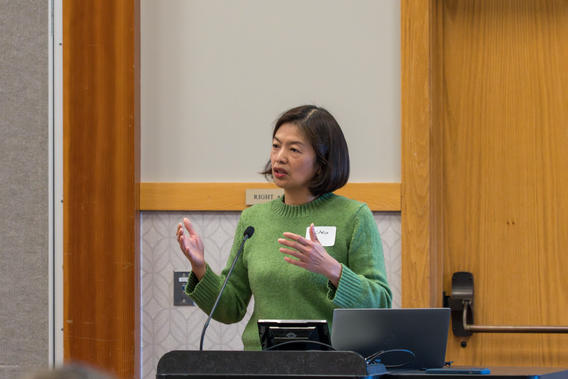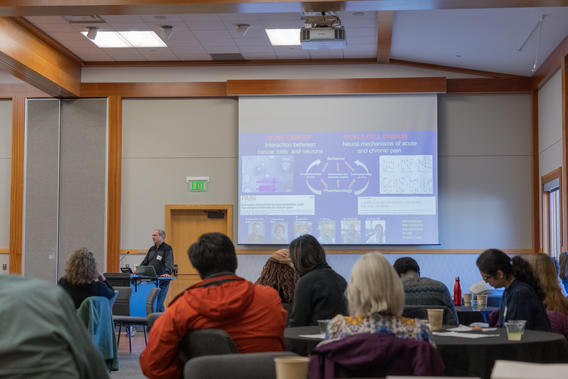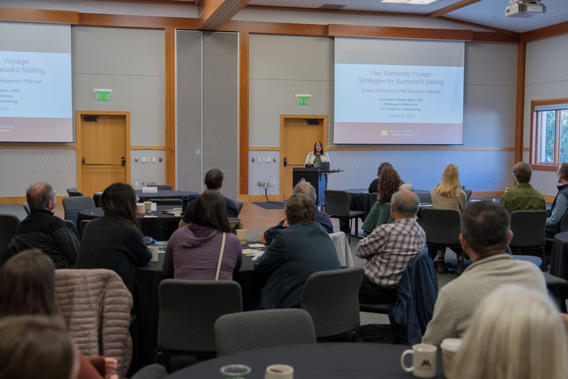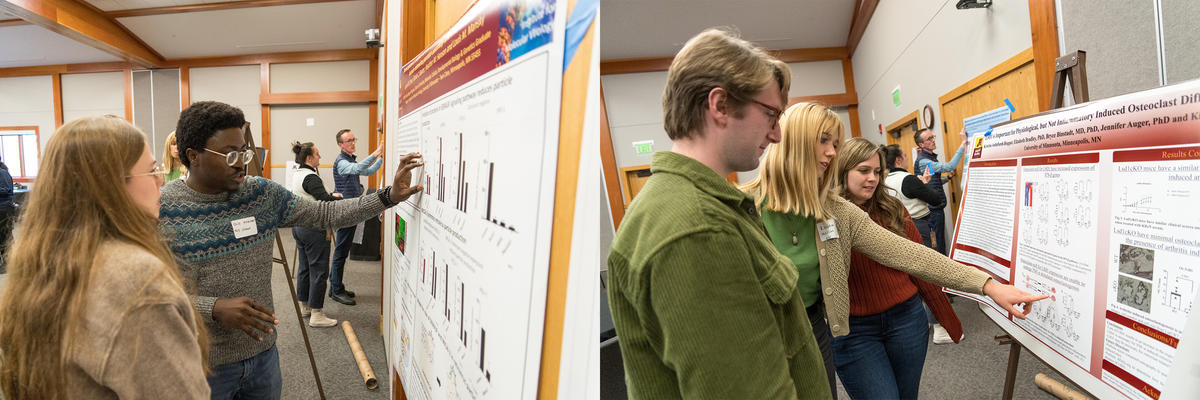Fall Research Retreat highlights new horizons of discovery in oral biology, cancer and digital technologies


On October 20, faculty, staff and learners from the School of Dentistry gathered at the Minnesota Landscape Arboretum for the returning Fall Research Retreat. Attendees listened to “5-Minute Talks” by School of Dentistry researchers and explored the grounds of the Minnesota Landscape Arboretum on art tours.
After lunch, there was a keynote address by Anne Weber-Main, PhD, professor of palliative care at the University of Minnesota Medical School and co-director of mentoring at the Clinical and Translational Science Institute. Weber spoke on fostering mentorships that build independence. The Retreat concluded with attendees gathering with research students presenting their explorations.
“5-Minute Talks” showcase advances in oral healthcare
The retreat featured two sessions of “5-Minute Talks,” where researchers gave an extended elevator-style introduction to their discoveries and impacts on oral healthcare.

Bruno Lima, DDS, PhD studies how biofilms form, with a particular focus on dental plaque biofilm. “We're also very interested in how shear forces affect dental plaque development,” he shared “We know that in the oral cavity, there are a number of shear forces that occur when we are speaking, or when we are eating or drinking water, and even with no shearing action, just the amount of saliva that has been produced in the oral cavity at all times affects biofilm.” Lima’s research shows that there are a number of species of bacteria that respond to different amounts of shear forces using artificial models.
Boyen Huang, DDS, MHA, PhD focuses on enhancing the visibility, accessibility and usability of teledentistry technology. “How can we make teledentistry usable and also a better idea to improve validity?,” Huang asked. “When teledentistry was invented, it was not for the pandemic. It was to improve access to rural regional areas and improve access to dental or medical services.” His team is working with the University of Minnesota College of Science and Engineering to develop AI tools to help providers diagnose and treat oral health symptoms using multiple patient-submitted imagery to form 3D virtual models of impacted areas.

Hooi Pin Chew, BDS, FDSRCS, PhD is leading research focused on prevention. “We simulate the development of plaque and simulate the development of calculus [calcified dental plaque], which I think is quite novel, because so far, there isn't anything in the literature that describes the development of artificial calculus,” she said. Chew and her team use the School of Dentistry’s artificial chewing machine to improve the prevention of plaque build-up and other symptoms.
Massimo Costalonga, DMD, PhD is collaborating with School of Dentistry colleagues to better understand how periodontal disease begins and how microorganisms interact with the immune system in the oral cavity. “In our findings in vivo, we find that the presence of calprotectin reduces the inflammatory component of the response,” he explained. “If you don't have this calprotectin you have more inflammatory cells.”
Thorsten Gruenheid, DDS, Dr med dent, PhD, MHA is exploring new ways to apply digital technologies to orthodontic care.Gruenheid is investigating three new methods: a project that looks at the bracket placement consistency of AI-assisted indirect bonding methods, T remote monitoring of clear aligner therapy to optimize patients specific treatments using patient-submitted photos and teledentistry, and the advancement of digital fabrication of nasal alveolar molding devices for infants with cleft and palate. “We want to try to bring this process into the digital world, and to essentially come up with an Invisalign-like process, in that we take an intraoral scan to get a virtual model, digitally modify that and come up with a series of models,” he explained. “We can then design a series of appliances, on those virtual models, 3D print them and give the patient a series of appliances that they wear.” Gruenheid shared that these digital and teledentistry advances will improve access to care and reduce cost for the healthcare system.
Jose Maldonado-Ortiz, DDS conducts research with the Institute for Molecular Virology. His team is exploring hepatitis C infections related to dry mouth. Studies of humans with advanced-stage hepatitis C show relationships with dry mouth and an increased level of fibrosis. Maldonado-Ortiz seeks to expand this research using a mouse model to better study the early stages of this viral relationship and larger patient pools for human studies.

Donald Simone, PhD leads a laboratory that studies neural mechanisms of pain and hyperalgesia, or hypersensitivity. “Unfortunately, for all of us here, the most common forms of cancer—breast cancer, prostate cancer and lung cancer—metastasize to bone. And when that happens, it becomes really painful,” he said. Approximately 80-85% of patients in late-stage bone cancer are in severe pain. Simone’s team also studies neural mechanisms of pain in sickle cell disease. Reducing pain is a major quality-of-life issue for millions of Americans with late-stage cancer or advanced sickle cell disease.
Weber-Main Shares New Best Practices for Mentorship

Weber-Main’s interest in mentorship in the scientific and academic community stems from her own journey of being both a mentee and a mentor. “I've been mentored along the way to be successful, where I went from a graduate degree in chemistry into the medical school environment, and immediately became immersed in faculty development in the area of research,” she said. “It's important to always acknowledge that no one should have just one mentor.A model to consider is for an individual to have a mentoring network, or in this case, a mentoring map,” referencing a diagram from National Center for Faculty Development and Diversity.
Weber-Main also shared her perspective on the value of ‘mentorship,’ rather than ‘mentoring,’ when it comes to the mentor-mentee relationship. “The word mentoring gives the impression of something that we do as a mentor, and that's done to you, as a mentee,” she explained. “Mentorship evokes a sense of fellowship, which is about inclusion, and we're all in fellowship together.”

Opportunities for future research retreats
Concluding the day, Kristin Artinger, PhD, Assistant Dean for Research and Discovery, reflected on how the Fall Research Retreat was designed to encourage research faculty, staff, and learners from different topic clusters engage with each other and inspire new avenues of discovery. “We reset some of the specific areas of research interests in the school and clustered them together so that we have more ways to interact,” she said. “I'm trying to build those, having different clusters that we can fit under and talk and interact with each other.”
With the autumn season change and the beauty of the Minnesota Landscape Arboretum, attendees enjoyed a day to meet across disciplines and reflect on best practices for mentorship of the next generation of School of Dentistry researchers.